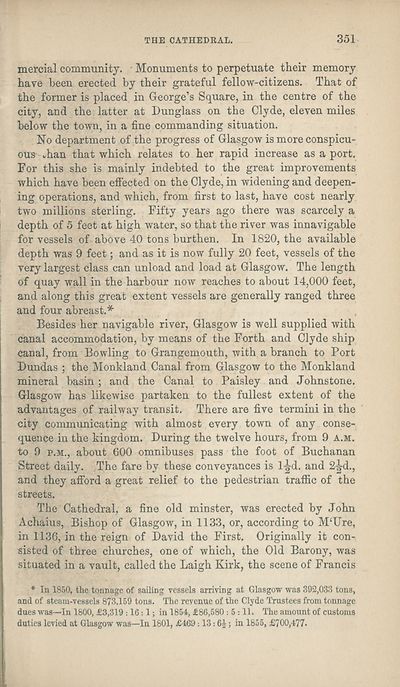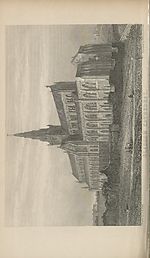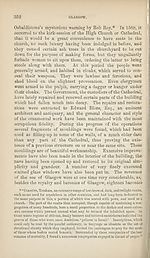Download files
Complete book:
Individual page:
Thumbnail gallery: Grid view | List view

THE CATHEDRAL.
351
mercial community. - Monuments to perpetuate their memory
have been erected by their grateful fellow-citizens. That of
the former is placed in George’s Square, in the centre of the
city, and the latter at Dunglass on the Clyde, eleven miles
below the town, in a fine commanding situation.
No department of the progress of Glasgow is more conspicu¬
ous .han that which relates to her rapid increase as a port.
For this she is mainly indebted to the great improvements
which have been effected on the Clyde, in widening and deepen¬
ing operations, and which, from first to last, have cost nearly
two millions sterling. Fifty years ago there was scarcely a
depth of 5 feet at high water, so that the river was innavigable
for vessels of above 40 tons burthen. In 1820, the available
depth was 9 feet; and as it is now fully 20 feet, vessels of the
very largest class can unload and load at Glasgow. The length
of quay wall in the harbour now reaches to about 14,000 feet,
and along this great extent vessels are generally ranged three
and four abreast.*
Besides her navigable river, Glasgow is well supplied with
canal accommodation, by means of the Forth and Clyde ship
canal, from Bowling to Grangemouth, with a branch to Port
Dundas ; the Monkland Canal from Glasgow to the Monkland
mineral basin ; and the Canal to Paisley and Johnstone.
Glasgow has likewise partaken to the fullest extent of the
advantages of railway transit. There are five termini in the
city communicating with almost every town of any conse¬
quence in the kingdom. During the twelve hours, from 9 a.m.
to 9 p.m., about 600 omnibuses pass the foot of Buchanan
Street daily. .The fare by these conveyances is 1-^d. and 2^d.,
and they afford a great relief to the pedestrian traffic of the
streets.
The Cathedral, a fine old minster, was erected by John
Achaius, Bishop of Glasgow, in 1133, or, according to M'Ure,
in 1136, in the reign of David the First. Originally it con¬
sisted of three churches, one of which, the Old Barony, was
situated in a vault, called the Laigh Kirk, the scene of Francis
* In 1850, the tonnage of sailing vessels arriving at Glasgow was 392,033 tons,
and of steam-vessels 873.159 tons. The revenue of the Clyde Trustees from tonnage
dues was—In 1800, £3,319 :16:1; in 1854, £86,580 :5 :11. The amount of customs
duties levied at Glasgow was—In 1801, £469:13: 6J; in 1855, £700,477.
351
mercial community. - Monuments to perpetuate their memory
have been erected by their grateful fellow-citizens. That of
the former is placed in George’s Square, in the centre of the
city, and the latter at Dunglass on the Clyde, eleven miles
below the town, in a fine commanding situation.
No department of the progress of Glasgow is more conspicu¬
ous .han that which relates to her rapid increase as a port.
For this she is mainly indebted to the great improvements
which have been effected on the Clyde, in widening and deepen¬
ing operations, and which, from first to last, have cost nearly
two millions sterling. Fifty years ago there was scarcely a
depth of 5 feet at high water, so that the river was innavigable
for vessels of above 40 tons burthen. In 1820, the available
depth was 9 feet; and as it is now fully 20 feet, vessels of the
very largest class can unload and load at Glasgow. The length
of quay wall in the harbour now reaches to about 14,000 feet,
and along this great extent vessels are generally ranged three
and four abreast.*
Besides her navigable river, Glasgow is well supplied with
canal accommodation, by means of the Forth and Clyde ship
canal, from Bowling to Grangemouth, with a branch to Port
Dundas ; the Monkland Canal from Glasgow to the Monkland
mineral basin ; and the Canal to Paisley and Johnstone.
Glasgow has likewise partaken to the fullest extent of the
advantages of railway transit. There are five termini in the
city communicating with almost every town of any conse¬
quence in the kingdom. During the twelve hours, from 9 a.m.
to 9 p.m., about 600 omnibuses pass the foot of Buchanan
Street daily. .The fare by these conveyances is 1-^d. and 2^d.,
and they afford a great relief to the pedestrian traffic of the
streets.
The Cathedral, a fine old minster, was erected by John
Achaius, Bishop of Glasgow, in 1133, or, according to M'Ure,
in 1136, in the reign of David the First. Originally it con¬
sisted of three churches, one of which, the Old Barony, was
situated in a vault, called the Laigh Kirk, the scene of Francis
* In 1850, the tonnage of sailing vessels arriving at Glasgow was 392,033 tons,
and of steam-vessels 873.159 tons. The revenue of the Clyde Trustees from tonnage
dues was—In 1800, £3,319 :16:1; in 1854, £86,580 :5 :11. The amount of customs
duties levied at Glasgow was—In 1801, £469:13: 6J; in 1855, £700,477.
Set display mode to:
![]() Universal Viewer |
Universal Viewer | ![]() Mirador |
Large image | Transcription
Mirador |
Large image | Transcription
| Antiquarian books of Scotland > Scotland/Scots > Black's picturesque tourist of Scotland > (455) |
|---|
| Permanent URL | https://digital.nls.uk/130033650 |
|---|
| Description | Thousands of printed books from the Antiquarian Books of Scotland collection which dates from 1641 to the 1980s. The collection consists of 14,800 books which were published in Scotland or have a Scottish connection, e.g. through the author, printer or owner. Subjects covered include sport, education, diseases, adventure, occupations, Jacobites, politics and religion. Among the 29 languages represented are English, Gaelic, Italian, French, Russian and Swedish. |
|---|

